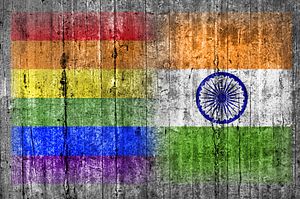When the rest of the world commemorated the anniversary of the Stonewall Inn movement in late-June with pride marches through the week (and the month), India was not left behind. While some cities like Mumbai held their annual marches earlier in the year, several others joined the world in celebration last week – including Chennai and Delhi which continued their annual tradition, and Nagpur and Gurgaon which had their very first marches, and Visakhapatnam, which raised funds for an official march later this month. This comes at a time when openly gay celebrities are attempting to take a stand in India regarding LGBTQ rights.
For instance, Prince Manvendra Singh Gohil, the country’s first openly gay prince, led the Los Angeles parade for the AIDS Healthcare foundation and has always been a vocal advocate for LGBT rights as well as better education and awareness of HIV/AIDS. Moreover, earlier this month, five gay celebrities petitioned the Indian Supreme Court to declare Section 377 of the Indian Penal Code, a colonial-era law, unconstitutional. The 65-page petition is from Navtej Singh Johar (a dancer), Sunil Mehra (a journalist), Ritu Dalmia (a chef and author), Aman Nath (a writer and historian), and Ayesha Kapur (a business executive), each of whom outline both their professional achievements as well as the way they have been hampered by this discriminatory law.
The problem in India is that a colonial law that forbids “carnal intercourse” against the “order of nature” and thereby severely restricts and outlaws the exercise of sexuality by sexual minorities. Section 377 of the Indian Penal Code, which states this law, was temporarily repealed by a Delhi High Court verdict in 2009 but reconstituted in 2013 when the Supreme Court of India found this repeal to be judicial overreach – thus delivering a crushing blow to activists and the movement.
In February 2016, the Supreme Court agreed to hear petitions filed against this archaic law, to examine its constitutional validity and constituted a five-panel bench. This most recent petition adds to the ones filed already by the Naz Foundation as well as other gay rights groups. However, as it was the first time people directly affected by the law spoke of their experience and the rights they were denied within the petition, there was a plea to hear it afresh. This was denied by the Supreme Court and referred instead to the Chief Justice of India alongside others on similar themes.
The pressure to repeal this law is rising as, for the first time, diplomats from 27 countries have issued a joint statement affirming their commitment to LGBTI rights. Diplomats themselves have faced discomfort in this regard, in the cases where their spouses are provided dependent visas that allow them to reside in India. In 2013, the situation escalated to the point where senior BJP official Yashwant Sinha even suggested at one point that if Indian diplomats in the United States had to adhere to U.S. laws, then by Indian law, the same-sex partners of U.S. diplomats in India could be arrested. Although the joint statement recently issued does not explicitly mention the furor surrounding Section 377, the fact that this was issued at the American Library’s event in tandem with the U.S. Embassy in New Delhi does set some context. Moreover, it noted that India has been relatively more progressive on the count of transgender rights alone.
However, there too contradictions emerge. While on one hand the laws in India grant transgender individuals legal rights and protections, Section 377 continues to discriminate against individuals within the community who engage in more fluid sexual practices. Although the category of a ‘Third Gender’ has been formally recognized in India, in practice it still has relatively narrow implications as it places individuals within set definitions of what that third gender means. Queer individuals who appear to fit the categories of male or female, but wish to transcend this dichotomy in practice are still relegated into one category or the other without regard for their desire to escape both categories of sex. For instance, in a recent clarification, the court has declared that the term transgender may not be applied to lesbian, gay and bisexual individuals – essentially implying that individuals who wish to identify as ‘transgender’ or across gender binaries (male/female) may not do so legally unless they fell within the strict idea of what the legally proscribed third gender meant.
Where does that leave the broader LGBT movement? For one thing, members of the movement across the spectrum need to wait on the panel’s decision regarding re-examination of the law. Further, this re-examination also needs to take into account the fluid experience of sexuality and gender and not thrust individuals into more unfair binaries, as the ‘third gender’ definition continues to do for several individuals. The battle to repeal the law has been raging since 1991 – but given its deep-seated underpinnings, a revisiting of this law will need to be as complex and layered as the myriad rights and experiences it would seek to protect.

































